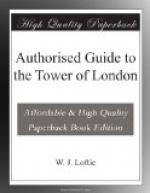In the window recess behind are shields and horns. In the next enclosure are three foot figures of the end of the fifteenth century and commencement of the sixteenth century; the first holds a long-handled axe as used for encounters on foot in champ clos. The second holds a two-handled sword. The third suit is enriched with engraving, and was formerly parcel gilt, but the helmet does not belong to the suit.
In the centre of the room is an equestrian figure (III), the man wearing a fine early sixteenth-century suit of armour, bearing the Nuremberg stamp, and the horse protected by a barb richly repousse, engraved, and formerly silvered. The designs on this display the Burgundian cross ragule and the flint and steel. The steel or briquet is to be seen also in the hinges and in the metal coverings for the reins. It will be remembered that this design forms the motif of the collar of the Golden Fleece.
The next equestrian figure (IV) shows the fluted, or as it was called crested, armour, of about 1500. The horse armour is also fluted. On the right, in the centre of the room, are two armours which belonged to Henry VIII. Of these the first (XXVIII) is that formerly described as “rough from the hammer,” though it has been milled or glazed and no hammer marks are visible. It is a complete suit for fighting on foot in the lists, and comfort and ability to move about, have been sacrificed to perfect protection. The suit weighs about 93 lbs., and is composed of no less than 235 separate pieces of metal. Some details of construction point to a Spanish influence in the style. The second figure (XXIX), which wants the leg armour, is of the kind known as a tonlet, and has a skirt of horizontal lames engraved. The helmet bears the well-known stamp of the Missaglia family of armourers, and is very curious and massive. This armour is also for fighting on foot in champ clos or the lists.
The next suit (VI) on the left is one of Henry VIII, and has been parcel gilt; the weight of the man’s armour is 81 lbs. The two foot figures are those of a horseman and an officer of foot, both of Henry’s time. The first bears on it Nuremberg marks; the second has an engraving of the Crucifixion on the left breast. The next equestrian figure (VII), also of Henry VIII, much resembles the last, and has at its feet extra pieces for the tilt yard. Other extra pieces which might be worn with these two suits are in the Royal Armoury at Windsor Castle.
The suit (V) on the equestrian figure in the middle of the room is one of the finest in existence. It was made by Conrad Seusenhofer, one of a family of Augsburg armourers, and given in 1514 to Henry VIII by the Emperor Maximilian. The man’s armour is engraved with roses, pomegranates, portcullises, and other badges of Henry VIII and his first queen Katharine of Arragon, and has on the metal skirt which imitates the cloth bases of the time the letters H and K. The horse armour, probably made afterwards in England by one of Henry’s German armourers, is also covered with engraving, and has panels on which are depicted scenes from the life and death of St. George and St. Barbara, both military saints. The whole armour was formerly washed with silver, of which some traces still remain.




